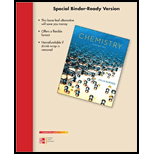
Concept explainers
A human brain weighs about 1 kg and contains about
Interpretation:
The length of one side of each cell if it were a cube and the surface area if cells are spread out into a thin layer are to be calculated.
Concept introduction:
Dimensional analysis is used to set up and solve a unit conversion problem using conversion factors.
Dimensional analysis is a way to convert units of measurement. In order to convert one unit to another, the relationship between those units is to be predicted. These relationships are called conversion factors.
Answer to Problem 70QP
Solution:
Explanation of Solution
Given information: The mass of the brain
The number of cells
The density of water
The mass of a brain cell is as follows:
Assume that each cell is completely filled with water.
The volume of each cell is as follows:
Assume that the cell is cubic.
The volume of a cube is as:
Here,
Rearrange the above equation to determine the length.
The length of a single cell is as:
So, the length of a single cell is
There are
A single cell thick surface area can be calculated as follows:
First, calculate the volume for total cells and then calculate the surface area.
The volume of total cells is as follows:
Substitute the values of height (equal to length) of a cell and volume of total cells in equation (1).
Hence, the surface area is
The length of one side of each cell is
Want to see more full solutions like this?
Chapter 1 Solutions
Chemistry - With Access (Looseleaf) (Custom)
- Suppose a room is 18 m long, 15 m wide, and the distance from floor to ceiling is 2.9 m. What is the room’s volume in cubic meters? In cubic centimeters? In liters?arrow_forwardA typical laboratory beaker has a volume of 250. mL What is its volume in cubic centimeters? In liters? In cubic meters?In cubic decimeters?arrow_forwardThe radius of an atom is on the order of1010 m. What is this radius in centimeters? In inches? In nanometers?arrow_forward
- A sample of sand is found to have a mass of 12.0 g and to have a volume of 2.69 cm3. What is its density in grams per cubic centimeter?arrow_forwardThe cup is a measure of volume widely used in cook-books. One cup is equivalent to 225 mL. What is the density of clover honey (in grams per milliliter) if three quarters of a cup has a mass of 252 g?arrow_forwardFor these questions, be sure to apply the rules for significant figures. a You are conducting an experiment where you need the volume of a box; you take the length, height, and width measurements and then multiply the values together to find the volume. You report the volume of the box as 0.310 m1. If two of your measurements were 0.7120 m and 0.52145 m, what was the other measurement? b If you were to add the two measurements from the first part of the problem to a third length measurement with the reported result of 1.509 m, what was the value of the third measurement?arrow_forward
- Bromine is a red-brown liquid with a density of 3.10 g/mL. A sample of bromine weighing 88.5 g occupies what volume?arrow_forwardA sample of a bright blue mineral was weighed in air, then weighed again while suspended in water. An object is buoyed up by the mass of the fluid displaced by the object. In air, the mineral weighed 7.35 g; in water, it weighed 5.40 g. The densities of air and water are 1.205 g/L and 0.9982 g/cm3, respectively. What is the density of the mineral?arrow_forwardSilver metal has a density of 10.40 g/cm3. What is the volume, in cubic centimeters, of a 100.0-g bar of silver metal?arrow_forward
 General Chemistry - Standalone book (MindTap Cour...ChemistryISBN:9781305580343Author:Steven D. Gammon, Ebbing, Darrell Ebbing, Steven D., Darrell; Gammon, Darrell Ebbing; Steven D. Gammon, Darrell D.; Gammon, Ebbing; Steven D. Gammon; DarrellPublisher:Cengage Learning
General Chemistry - Standalone book (MindTap Cour...ChemistryISBN:9781305580343Author:Steven D. Gammon, Ebbing, Darrell Ebbing, Steven D., Darrell; Gammon, Darrell Ebbing; Steven D. Gammon, Darrell D.; Gammon, Ebbing; Steven D. Gammon; DarrellPublisher:Cengage Learning Chemistry: Principles and ReactionsChemistryISBN:9781305079373Author:William L. Masterton, Cecile N. HurleyPublisher:Cengage Learning
Chemistry: Principles and ReactionsChemistryISBN:9781305079373Author:William L. Masterton, Cecile N. HurleyPublisher:Cengage Learning Chemistry & Chemical ReactivityChemistryISBN:9781337399074Author:John C. Kotz, Paul M. Treichel, John Townsend, David TreichelPublisher:Cengage Learning
Chemistry & Chemical ReactivityChemistryISBN:9781337399074Author:John C. Kotz, Paul M. Treichel, John Townsend, David TreichelPublisher:Cengage Learning Chemistry: The Molecular ScienceChemistryISBN:9781285199047Author:John W. Moore, Conrad L. StanitskiPublisher:Cengage Learning
Chemistry: The Molecular ScienceChemistryISBN:9781285199047Author:John W. Moore, Conrad L. StanitskiPublisher:Cengage Learning
 General, Organic, and Biological ChemistryChemistryISBN:9781285853918Author:H. Stephen StokerPublisher:Cengage Learning
General, Organic, and Biological ChemistryChemistryISBN:9781285853918Author:H. Stephen StokerPublisher:Cengage Learning





